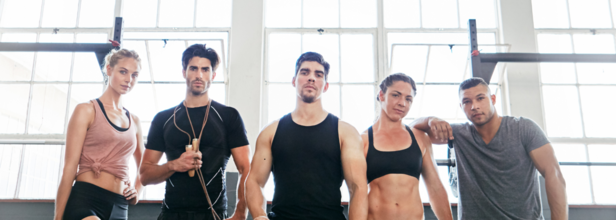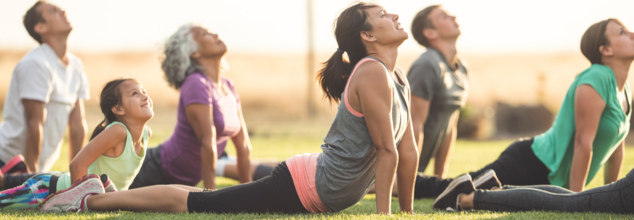- Health Conditions A-Z
- Health & Wellness
- Nutrition
- Fitness
- Health News
- Ayurveda
- Videos
- Medicine A-Z
- Parenting
- Web Stories
7 Yoga Poses That Make Up For Missing Gym Workout Days

(Credit-Canva)
While gym is a great way to ensure you stay active, we have all had days when it feels too overwhelming to go to the gym. It could be because you had a long day or are unable to travel to your gym. On such days you could substitute your gym workout with something you can do at home. That is where yoga comes in. Not only can it help you build strength but can be a great way to enhance your muscle recovery from previous days of exercising in the gym.
Why Do Some People Prefer Doing Yoga?
First, yoga offers a more complete approach to well-being. It’s not just about building muscles; it also focuses on your breath and mind, helping to reduce stress and improve focus. Many people find this mental benefit is something they don't get as much from a regular gym session. It is also great for flexibility and balance, aspects often overlooked in typical gym routines. The slow, controlled movements help lengthen muscles and make your joints more mobile, which can even prevent injuries.
Yoga is usually low-impact, meaning it's gentler on your joints. Because of its adaptable nature, if you have joint issues, are recovering from an injury, or just want a workout, that's a great way to ensure your body is getting movement while recovering. You can do it almost anywhere with just a mat, making it easy to fit into a busy schedule without needing a gym membership or specific equipment.
Boat Pose (Paripurna Navasana)
This pose powerfully engages your abdominal muscles, hip flexors, and quadriceps. Holding it requires significant core stability, helping to tone your midsection and improve overall body control. It's a challenging pose that builds core strength, much like crunches or leg raises at the gym.
Bridge Pose (Setu Bandhasana)
Bridge Pose mainly strengthens your buttocks, hamstrings, and lower back. Lifting your hips works these areas, similar to gym glute bridges. It also helps stretch the front of your body, easing stiffness from sitting a lot.
Locust Pose (Salabhasana)
By lifting your head, chest, and legs, you powerfully engage your back muscles, buttocks, and hamstrings. This pose is like doing back extensions, building a strong, healthy spine. It's fantastic for strengthening all the muscles along your back.
Plank Pose (Phalakasana)
Holding a straight line from head to heels strongly works your core, shoulders, chest, and thighs. It's a key exercise for building endurance and muscle tone throughout your whole body. Plank is an excellent all-around strength builder.
Low Push-Up (Chaturanga Dandasana)
This pose is like a yoga push-up, intensely working your triceps, shoulders, and chest. It also needs strong core control to stay straight. It builds dynamic upper body power, improving your push-up ability.
Side Plank Pose (Vasisthasana)
This pose really strengthens your side abs, shoulders, and wrists. It takes strong core stability to hold yourself sideways. Side Plank is excellent for balance and working those side abdominal muscles.
Dolphin Plank (Ardha Pincha Mayurasana)
On your forearms, this pose focuses heavily on your shoulders, triceps, and deep core muscles. It builds impressive upper body endurance and core strength, similar to forearm planks at the gym. It's a challenging pose for overall stability.
Matching Your Workout With Your Personality Can Make Fitness Fun

Credits: Canva
If you've ever struggled to maintain a regular workout routine, it might not just be about willpower or lack of time, it could have more to do with your personality than you think.
A recent study published on July 7 in the journal Frontiers in Psychology by researchers at University College London suggests that tailoring your workouts to your personality type could make exercising more enjoyable and sustainable.
So if you are having a hard time to workout, maybe you can try matching it with your personality. It can do wonders.
The Link Between Personality and Exercise Habits
The study explored how the five major personality traits, also known as the “Big Five”, influence exercise preferences and overall enjoyment. These traits include:
- Conscientiousness
- Agreeableness
- Neuroticism
- Openness
- Extraversion
While everyone has a unique personality, these five dimensions are often used in psychology to understand general behavioral tendencies. The researchers hypothesized that by aligning workouts with individual personality traits, people might experience improved motivation and consistency.
A Closer Look at the Study
The research involved 132 volunteers of varying fitness levels and backgrounds. Participants were randomly divided into two groups: one followed an eight-week structured workout program involving cycling and strength training, while the other group performed light stretching. Fitness levels were measured at the beginning and end of the study through assessments like VO₂ max, push-ups, and planks. Participants also completed a personality survey and reported their stress levels.
By the end of the trial, 86 participants had completed the program. Regardless of their personality, those who completed the workouts showed marked improvements in fitness metrics. But digging deeper, the researchers found more nuanced connections between specific personality traits and how people approached exercise.
What Your Personality Says About Your Workout Style
Different traits showed interesting links with workout preferences and results. For instance:
- Extraverts gravitated toward high-intensity workouts, like interval training and challenging cycling sessions. These individuals seemed to thrive in high-energy environments.
- Those high in neuroticism, who may be more prone to anxiety or emotional ups and downs, preferred exercising in private spaces like their homes. They also tended to avoid sharing heart rate data, suggesting a preference for less scrutiny.
- Participants with high agreeableness enjoyed longer but easier rides, highlighting a possible tendency to choose less competitive or aggressive forms of exercise.
- Conscientious individuals didn’t show a specific preference for workout type. However, their overall commitment to completing tasks and achieving goals made them successful in sticking with the program, regardless of the exercise format.
- Interestingly, only neuroticism had a clear effect on stress reduction. Participants who scored high in this trait were the only group to show a notable drop in stress levels after exercising regularly. This suggests that for some, particularly those who struggle with anxiety or stress, consistent movement could have deeper emotional benefits.
Why This Matters for Long-Term Fitness
While the study emphasizes the potential for more personalized workout strategies based on personality, it also acknowledges the complexity of human behavior. Most people don’t fit neatly into one personality category, they often exhibit traits from multiple domains, which can make it tricky to design a one-size-fits-all fitness plan.
So rather than relying solely on personality assessments, the researchers suggest looking at past behaviors and preferences as a starting point. Reflecting on what’s worked in the past, whether you prefer working out alone or in groups, or whether your goals are more performance, or health-focused, can provide clearer guidance than personality tests alone.
Ultimately, the key takeaway is this: knowing yourself better can help you move better. Whether it’s high-energy gym classes, quiet yoga at home, or brisk outdoor walks, aligning your workouts with your unique preferences—and yes, your personality—could make all the difference in making exercise a lasting habit.
Making This Small Change While Walking Could Strengthen And Counter Frailty In Seniors

(Credit-Canva)
Walking is the best activity a person can do, especially for elderly people. Not only is it adaptable but cost effective and something people can do according to their own needs. It is said to be the best exercise for the elderly, but how can you maximize walking to reap all the benefits? A new study found that making this small change in the way you walk can make all the difference in the world
Adding a little more energy to their steps can significantly improve the health and independence of older adults, according to a new study. Researchers found that seniors who slightly increased how fast they walked saw big improvements in their physical abilities.
Just a Few More Steps Make a Big Difference
The study, recently shared in a science journal, showed that taking just 14 or more extra steps each minute made a real impact. One of the lead researchers explained that even just casual walking had good effects on the people in their study.
For the research, the team worked with 102 older individuals. They were about 79 years old on average and lived in retirement homes near Chicago. All of them were either frail or close to being frail. Some were simply asked to walk regularly at a relaxed speed, while others joined a program focused on walking faster. The faster walkers were encouraged to move "as fast as they safely could."
Overall, the seniors in the faster walking group increased their speed to about 100 steps per minute, while those walking casually averaged around 77 steps per minute. The results clearly showed that seniors performed better on a six-minute walking test if they increased their usual walking speed by just 14 steps per minute.
Real-World Impact of Improved Walking
These kinds of improvements can mean a huge amount to someone who is struggling with frailty. As one of the researchers pointed out, people who haven't experienced being frail might not understand how much of a difference it makes to be able to go to the grocery store without getting tired, or not needing to sit down when they're out. Being able to do everyday tasks without feeling exhausted can greatly improve an older person's daily life and help them remain independent.
Tools to Help You Get Started
Because of these good findings, the research team created a smartphone app called "Walk Test." This app can accurately measure how fast someone is walking. The app was designed to be easy for older adults to use without needing any extra equipment. The researchers noted that those who need the most help often have the fewest tools to get started, which is why they made the app simple to use.
The main researcher suggests that seniors first find out their normal walking pace to know where they're starting. Then, they should try to walk a bit faster, finding a speed that feels quicker but is still comfortable. Phone apps with a metronome (which makes a steady beat) can also help. Seniors can try to match their steps to this beat, helping them keep a steady, faster pace.
Broad Benefits of Activity
Walking briskly offers many other health benefits for seniors, as another researcher, a professor of kinesiology, pointed out. Experts suggest physical activity has widespread benefits for many parts of the body. It helps people live longer and lowers the risk for many common long-term illnesses like various cancers, heart disease, and diabetes.
It also improves brain health, makes thinking clearer, and reduces the risk for Alzheimer's disease and similar memory problems. Plus, it boosts mental health by reducing anxiety and sadness, and makes bones stronger. The most noticeable short-term benefits usually include feeling more pleasant and refreshed, sleeping better, and thinking more clearly.
10 Minute Warm-Up Yoga Poses That You Should Do Every Morning

(Credit-Canva)
“My 5-9 before my 9-5” has been a popular trend on social media. We see people waking up at the crack of dawn, going to work out, eat healthy and get their affairs in order before they start their workday. Although it is very admirable to see and inspiring, many of us struggle to find the time or motivation for intense workouts. Not only does it feel overwhelming but also unachievable. However, fitness and health are not just a one-way path; you can begin from anywhere and whichever way you are comfortable doing your exercises. Many chose to start with yoga.
Beginning your morning with a short yoga session is a fantastic way to ease into your day. Unlike high-impact exercises, yoga gently wakes up your body and mind. It helps you feel calm and centered, clearing out any lingering grogginess or stress from the night before.
This peaceful start allows you to connect with your breath and body, setting a wonderfully positive and mindful tone for the hours ahead. It's a quiet moment just for you, helping you approach your day with greater clarity and a more positive outlook.
Why is it Important To Stretch Every Morning?
Stretching in the morning is important because it gently wakes up your muscles and joints after a long night of rest. It helps to improve your flexibility and increase blood flow to your muscles, making them feel less stiff and more ready for the day's activities. A good morning stretch can also reduce tension and boost your energy, setting a positive tone for the entire day.
Cat-Cow Pose
Start on hands and knees. Breathe in, drop your belly and lift your chest like a cow. Breathe out, round your back and tuck your chin like a cat. This gently warms your spine and connects your breath to movement.
Downward-Facing Dog
From hands and knees, lift your hips high, making an upside-down 'V' shape. Spread your fingers wide and press your hands down. This pose stretches your whole body, including your legs and shoulders, and makes you feel energized.
Low Lunge
Step one foot forward between your hands, lowering your back knee. Keep your hands down or lift them up. This pose deeply stretches the front of your hips and thighs, and helps improve your balance. Remember to switch legs.
Child's Pose
Kneel with big toes touching and knees wide apart. Sit your hips back towards your heels and fold forward, resting your forehead. You can stretch your arms forward or beside you. This calms your mind and stretches your hips and ankles.
Seated Spinal Twist
Sit tall with legs out. Bend one knee and place that foot outside the other knee. Twist your body gently towards the bent knee. This pose makes your spine more flexible and helps with internal organ health. Don't forget to do both sides.
Cobra Pose
Lie on your stomach with hands under your shoulders. Gently lift your head and chest using your back muscles, keeping elbows close. This strengthens your back and stretches your belly, also helping with mild back discomfort.
Bridge Pose
Lie on your back with bent knees, feet flat and hip-width apart. Push into your feet and arms to lift your hips toward the ceiling. You can clasp hands underneath your back. This strengthens your back and glutes while gently stretching your chest.
Supine Spinal Twist
Lie on your back and hug both knees to your chest. Let your knees gently fall to one side, keeping your opposite shoulder down. Look the other way. This releases tension in your lower back and hips, promoting overall relaxation.
© 2024 Bennett, Coleman & Company Limited

